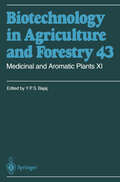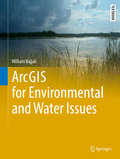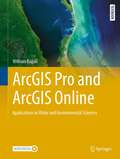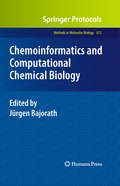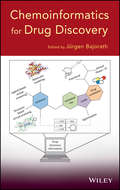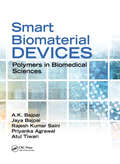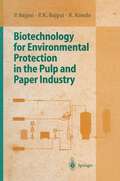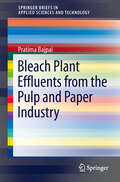- Table View
- List View
Plant Protoplasts and Genetic Engineering VI (Biotechnology in Agriculture and Forestry #34)
by Y. P. S. BajajTransgenic Crops II (Biotechnology in Agriculture and Forestry #47)
by Y. P. S. BajajThere has been tremendous progress in the genetic transformation of agricultural crops, and plants resistant to insects, herbicides, and diseases have been produced, field tested, and patented. This book compiles this information on various fruits and vegetables.
Robotics (Intelligent Systems, Control and Automation: Science and Engineering #43)
by Tadej Bajd Matjaž Mihelj Jadran Lenarčič Aleš Stanovnik Marko MunihNumerical Analysis of Vibrations of Structures under Moving Inertial Load (Lecture Notes in Applied and Computational Mechanics #65)
by Czesław I. Bajer Bartłomiej DyniewiczMoving inertial loads are applied to structures in civil engineering, robotics, and mechanical engineering. Some fundamental books exist, as well as thousands of research papers. Well known is the book by L. Frýba, Vibrations of Solids and Structures Under Moving Loads, which describes almost all problems concerning non-inertial loads.This book presents broad description of numerical tools successfully applied to structural dynamic analysis. Physically we deal with non-conservative systems. The discrete approach formulated with the use of the classical finite element method results in elemental matrices, which can be directly added to global structure matrices. A more general approach is carried out with the space-time finite element method. In such a case, a trajectory of the moving concentrated parameter in space and time can be simply defined.We consider structures described by pure hyperbolic differential equations such as strings and structures described by hyperbolic-parabolic differential equations such as beams and plates. More complex structures such as frames, grids, shells, and three-dimensional objects, can be treated with the use of the solutions given in this book.
Tubes, Sheets and Singularities in Fluid Dynamics: Proceedings of the NATO ARW held in Zakopane, Poland, 2–7 September 2001, Sponsored as an IUTAM Symposium by the International Union of Theoretical and Applied Mechanics (Fluid Mechanics and Its Applications #71)
by K. Bajer H. K. MoffattModern experiments and numerical simulations show that the long-known coherent structures in turbulence take the form of elongated vortex tubes and vortex sheets. The evolution of vortex tubes may result in spiral structures which can be associated with the spectral power laws of turbulence. The mutual stretching of skewed vortex tubes, when they are close to each other, causes rapid growth of vorticity. Whether this process may or may not lead to a finite-time singularity is one of the famous open problems of fluid dynamics. This book contains the proceedings of the NATO ARW and IUTAM Symposium held in Zakopane, Poland, 2-7 September 2001. The papers presented, carefully reviewed by the International Scientific Committee, cover various aspects of the dynamics of vortex tubes and sheets and of their analogues in magnetohydrodynamics and in quantum turbulence. The book should be a useful reference for all researchers and students of modern fluid dynamics.
ArcGIS for Environmental and Water Issues (Springer Textbooks in Earth Sciences, Geography and Environment)
by William BajjaliThis textbook is a step-by-step tutorial on the applications of Geographic Information Systems (GIS) in environmental and water resource issues. It provides information about GIS and its applications, specifically using the most advanced ESRI GIS technology and its extensions. Eighteen chapters cover GIS applications in the field of earth sciences and water resources in detail from the ground up. Author William Bajjali explains what a GIS is and what it is used for, the basics of map classification, data acquisition, coordinate systems and projections, vectorization, geodatabase and relational database, data editing, geoprocessing, suitability modeling, working with raster, watershed delineation, mathematical and statistical interpolation, and more advanced techniques, tools and extensions such as ArcScan, Topology, Geocoding, Hydrology, Geostatistical Analyst, Spatial Analyst, Network Analyst, 3-D Analyst. ArcPad, ESRI’s cutting-edge mobile GIS software, is covered in detail as well. Each chapter contains concrete case studies and exercises – many from the author’s own work in the United States and Middle East. This volume is targeted toward advanced undergraduates, but could also be useful for professionals and for anyone who utilizes GIS or practices spatial analysis in relation to geology, hydrology, ecology, and environmental sciences.
ArcGIS Pro and ArcGIS Online: Applications in Water and Environmental Sciences (Springer Textbooks in Earth Sciences, Geography and Environment)
by William BajjaliThis textbook serves as a practical guide for undergraduate and graduate students in geology, hydrology, ecology, and environmental sciences, teaching them applied GIS techniques. Presented as a step-by-step tutorial across seventeen chapters, the book starts with the fundamentals of GIS and progresses to real-life examples from geology and water resources. The focus is on ESRI's ArcGIS Pro, covering various tools for spatial, geostatistical, network, and 3-D analysis. Additionally, it explores ArcGIS Online and working with web apps like Web Map, StoryMaps, and GEO App.GIS applications, especially in water and environmental problem-solving, are rapidly growing worldwide. The demand for GIS experts utilizing spatial analysis in environmental science remains high. This textbook equips users with the necessary knowledge to become effective mappers and spatial analysts in the fields of environment, geosciences, and water resources, employing the latest state-of-the-art methodology.Each chapter provides exercises and supplementary materials available for download on SpringerLink, along with additional links for further learning opportunities.
Chemoinformatics and Computational Chemical Biology (Methods in Molecular Biology #672)
by Jürgen BajorathOver the past years, the chem(o)informatics field has further evolved and new application areas have opened up, for example, in the broadly defined area of chemical biology. In Chemoinformatics and Computational Chemical Biology, leading investigators bring together a detailed series of reviews and methods including, among others, system-directed approaches using small molecules, the design of target-focused compound libraries, the study of molecular selectivity, and the systematic analysis of target-ligand interactions. Furthermore, the book delves into similarity methods, machine learning, probabilistic approaches, fragment-based methods, as well as topics that go beyond the current chemoinformatics spectrum, such as knowledge-based modeling of G protein-coupled receptor structures and computational design of siRNA libraries. As a volume in the highly successful Methods in Molecular Biology™ series, this collection provides detailed descriptions and implementation advice that are exceedingly relevant for basic researchers and practitioners in this highly interdisciplinary research and development area. Cutting-edge and unambiguous, Chemoinformatics and Computational Chemical Biology serves as an ideal guide for experts and newcomers alike to this vital and dynamic field of study.
Chemoinformatics for Drug Discovery
by Jürgen BajorathChemoinformatics strategies to improve drug discovery results With contributions from leading researchers in academia and the pharmaceutical industry as well as experts from the software industry, this book explains how chemoinformatics enhances drug discovery and pharmaceutical research efforts, describing what works and what doesn't. Strong emphasis is put on tested and proven practical applications, with plenty of case studies detailing the development and implementation of chemoinformatics methods to support successful drug discovery efforts. Many of these case studies depict groundbreaking collaborations between academia and the pharmaceutical industry. Chemoinformatics for Drug Discovery is logically organized, offering readers a solid base in methods and models and advancing to drug discovery applications and the design of chemoinformatics infrastructures. The book features 15 chapters, including: What are our models really telling us? A practical tutorial on avoiding common mistakes when building predictive models Exploration of structure-activity relationships and transfer of key elements in lead optimization Collaborations between academia and pharma Applications of chemoinformatics in pharmaceutical research—experiences at large international pharmaceutical companies Lessons learned from 30 years of developing successful integrated chemoinformatic systems Throughout the book, the authors present chemoinformatics strategies and methods that have been proven to work in pharmaceutical research, offering insights culled from their own investigations. Each chapter is extensively referenced with citations to original research reports and reviews. Integrating chemistry, computer science, and drug discovery, Chemoinformatics for Drug Discovery encapsulates the field as it stands today and opens the door to further advances.
Chemoinformatics for Drug Discovery
by Jürgen BajorathChemoinformatics strategies to improve drug discovery results With contributions from leading researchers in academia and the pharmaceutical industry as well as experts from the software industry, this book explains how chemoinformatics enhances drug discovery and pharmaceutical research efforts, describing what works and what doesn't. Strong emphasis is put on tested and proven practical applications, with plenty of case studies detailing the development and implementation of chemoinformatics methods to support successful drug discovery efforts. Many of these case studies depict groundbreaking collaborations between academia and the pharmaceutical industry. Chemoinformatics for Drug Discovery is logically organized, offering readers a solid base in methods and models and advancing to drug discovery applications and the design of chemoinformatics infrastructures. The book features 15 chapters, including: What are our models really telling us? A practical tutorial on avoiding common mistakes when building predictive models Exploration of structure-activity relationships and transfer of key elements in lead optimization Collaborations between academia and pharma Applications of chemoinformatics in pharmaceutical research—experiences at large international pharmaceutical companies Lessons learned from 30 years of developing successful integrated chemoinformatic systems Throughout the book, the authors present chemoinformatics strategies and methods that have been proven to work in pharmaceutical research, offering insights culled from their own investigations. Each chapter is extensively referenced with citations to original research reports and reviews. Integrating chemistry, computer science, and drug discovery, Chemoinformatics for Drug Discovery encapsulates the field as it stands today and opens the door to further advances.
Smart Biomaterial Devices: Polymers in Biomedical Sciences
by A.K. Bajpai Jaya Bajpai Rajesh Kumar Saini Priyanka Agrawal Atul TiwariPolymers have emerged as one of the most innovative classes of materials in modern materials science, leading to new applications in medicine and pharmacy. This book offers a convincing and understandable approach to polymer biomaterial devices being used in various areas related to biomedical and pharmaceutical fields. The polymer materials finding application as biomaterials are discussed and described in detail pertaining to the areas of artificial implants, orthopedics, ocular devices, dental implants, drug delivery systems, burns and wounds.
Biotechnology for Environmental Protection in the Pulp and Paper Industry
by P. Bajpai R. KondoPulp and paper production has increased globally and will continue to increase in the near future. Approximately 155 million tons of wood pulp is produced worldwide and about 260 million is projected for the year 2010. To be able to cope with increasing demand, an increase in productivity and improved environmental performance is needed as the industry is also under constant pressure to reduce and modify environmental emissions to air and water. The authors give updated information on various biotechnological processes useful in the pulp and paper industry which could help in reducing the environmental pollution problem, in addition to other benefits. Various chapters deal with the latest developments in such areas as raw material preparation, pulping, bleaching, water management, waste treatment and utilization. The book also covers the environmental regulations in various parts of the world as well as the role of biotechnology in reducing environmental problems.
Advances in Bioethanol (SpringerBriefs in Applied Sciences and Technology)
by Pratima BajpaiThe book provides an updated and detailed overview on advances in bioethanol. It looks at the historical perspectives, chemistry, sources and production of ethanol and discusses biotechnology breakthroughs and promising developments. The book also provides the details regarding the uses, advantages, problems, environmental effects and characteristics of bioethanol as a fuel. In addition, it presents information about ethanol in different parts of the world and also highlights the challenges and future of ethanol.
Anaerobic Technology in Pulp and Paper Industry (SpringerBriefs in Applied Sciences and Technology)
by Pratima BajpaiThis book presents a state-of-the-art report on the treatment of pulp and paper industry effluents using anaerobic technology. It covers a comprehensive range of topics, including the basic reasons for anaerobic treatment, comparison between anaerobic and aerobic treatment, effluent types suitable for anaerobic treatment, design considerations for anaerobic treatment, anaerobic reactor configurations applied for treatment of pulp and paper industry effluents, present status of anaerobic treatment in pulp and paper industry, economic aspects, examples of full scale installations and future trends.
Biological Odour Treatment (SpringerBriefs in Environmental Science)
by Pratima BajpaiShowcasing the very latest technologies for neutralising the unpleasant—and sometimes dangerous—odours from industrial and waste management processes, this Springer Brief in Environmental Sciences covers physical, chemical and biological methods. The volume includes modern biotechnological approaches now making it cost-effective to tackle malodorous chemicals at very small concentrations. The book reflects the fact that odour affects us in several ways, which range from compromising our quality of life to causing respiratory and other unpleasant conditions and from depressing property values to severe health problems caused by the toxic stimulants of odours.Innumerable industrial processes release malodourous and harmful vapours. The human sense of smell can detect some noxious chemicals, such as the sulphurous by-products of paper manufacturing, at concentrations of one part per billion. This e-book shows what has been achieved in combating offensive and harmful odours. While conventional air pollution control technologies can treat a wide variety of pollutants at higher concentrations, the chapters cover the more refined biological methods used to deal with odours and volatile organic compounds in low concentrations. These include bio scrubbers and bio trickling filters. Standing alongside its detailed discussion of the health impacts of total reduced sulphur compounds, and the composition of paper pulp industry emissions, this publication offers comprehensive and in-depth treatment of some of the most potent anti-odour technologies yet devised.
Biotechnology for Pulp and Paper Processing
by Pratima BajpaiThe book provides the most up-to-date information available on various biotechnological processes useful in the pulp and paper industry. The first edition was published in 2011, covering a specific biotechnological process or technique, discussing the advantages, limitations, and prospects of the most important and popular processes used in the industry. Many new developments have taken place in the last five years, warranting a second edition on this topic. The new edition contains about 35% new material covering topics in Laccase application in fibreboard; biotechnology in forestry; pectinases in papermaking; stickies control with pectinase; products from hemicelluloses; value added products from biorefinery lignin; use of enzymes in mechanical pulping.
Biotechnology for Pulp and Paper Processing
by Pratima BajpaiThis book provides the most up-to-date information available on various biotechnological processes useful in the pulp and paper industry. Each of the twenty chapters covers a specific biotechnological process or technique, discussing the advantages, limitations, and future prospects of the most important and popular processes used in the industry. Topics covered include tree improvement, pulping, bleaching, deinking, fiber modification, biosolids management, and biorefining.
Bleach Plant Effluents from the Pulp and Paper Industry (SpringerBriefs in Applied Sciences and Technology)
by Pratima BajpaiThis book covers bleach plant effluents, that most polluting effluent from the pulp and paper industry. Disappearance of benthic invertebrates, a high incidence of fish diseases, and mutagenic effects on the aquatic fauna are some of the consequences of the disposal of bleach effluents into surface waters. This book describes environmental impact of bleach plant effluents, environmental regulations, and measures to reduce the pollution load by internal process modification and external treatment of bleach plant effluents.
Deep Eutectic Solvents for Pretreatment of Lignocellulosic Biomass (SpringerBriefs in Applied Sciences and Technology)
by Pratima BajpaiThis book focuses on the properties of deep eutectic solvents (DESs) and recent advances in their application in lignocellulosic biomass processing. Lignocellulosic biomass conversion to biofuels, biochemicals and other value-added products has attracted global attention because it is a readily available, inexpensive and renewable resource. However, in order for biomass technologies to be commercially viable, biomass recalcitrance needs to be cost-effectively reduced. Deep eutectic solvents (DESs) are new ‘green' solvents that have the high potential for biomass processing thanks to their low cost, low toxicity, biodegradability, and easy recycling and reuse. After an overview of the current lignocellulosic biomass pretreatment, the book discusses the synthesis and physiochemical properties of DESs, as well as key findings on the effects of DES on cellulose, hemicellulose and lignin solubilization, biomass pretreatment and biomass crystallinity. It then addresses the enzymatic hydrolysis performance of DES-pretreated solids, compatibility of DESs with enzymes and microorganisms, and the recycling potential of DESs. Lastly, it compares DESs with ionic liquids, and examines the challenges and opportunities relating to extending the use of DESs in lignocellulosic processing.
Depolymerization of Lignin to Produce Value Added Chemicals
by Pratima BajpaiEnables readers to convert lignin using a variety of depolymerization methods and develop it into industrially relevant and functional compounds Depolymerization of Lignin to Produce Value Added Chemicals summarizes the depolymerization and utilization of lignin from different sources and covers the emerging field of biological depolymerization, enabling the reader to identify the high added value of a biomass residue and support him/her in its possible use for mass and niche high impact application sectors. Lignin has great potential to significantly improve the economics of a biorefinery due to its conversion into value-added products. To illustrate, this book includes information on: Feasibility of large-scale implementation of covered technologies, including thermal, biological, and chemical depolymerization, especially in relation to potential industrial applications "Lignin-first" biorefining approach, and potential applications of lignin-derived monomers and their derivatives as bioactives in food, natural health products, and pharmaceuticals Business and market scenarios and challenges that intersect with lignin, along with perspectives on lignin valorization Benefits and drawbacks of a lignin-first approach to biorefining, and techno-economic considerations of lignin and its applicationsDepolymerization of Lignin to Produce Value Added Chemicals is an essential resource for researchers, chemists, engineers, analysts, and consultants within universities, independent research organizations, and government.
